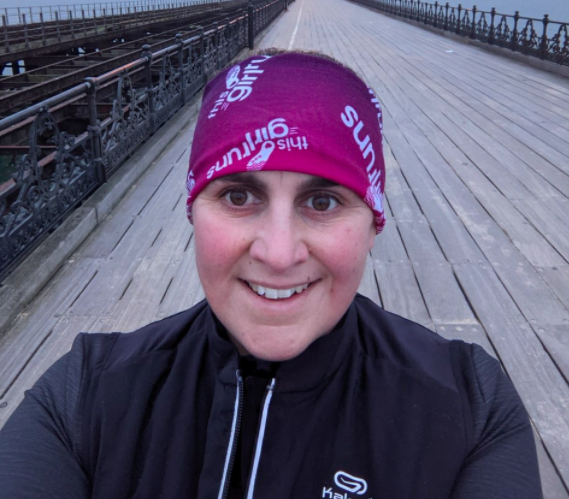So you’ve managed to run 5K… now what? It can be hard to stay motivated once you’ve reached your goal, which is why we’ve got three women to share how they used the 5K challenge as a starting point for getting stronger than ever.
Over the past year, many of us have turned to running as a way of keeping active when the gyms have been closed. To kick off the habit, more people have taken on the Couch to 5K challenge than ever before, with the official app reporting a 92% increase in downloads in the first lockdown, compared to the same period in 2019. In case you’ve missed the hype, the Couch to 5K (C25K) is a nine-week plan designed to help beginner runners work up to and complete a 5K; the app aims to equip people with the stamina to tackle the distance while offering advice from a roster of celebrity coaches, including radio DJ Jo Whiley, comedian Sarah Millican and US Olympic sprinter, Michael Johnson.
Achieving the distance is all well and good, but what happens once you finish the plan? How do you maintain your new found cardio fitness? We spoke to three C25K graduates to see how they kept on moving after reaching that all-important 5K mark.
You may also like
“My fitness tracker helped me learn to love interval running”
BEVERLY
“The first time I ran, I thought I was going to throw up,” recalls Beverly, who at 34 was re-learning how to run for the first time since doing PE at school. “But each time I went out and completed a run, I felt euphoric! I’d never experienced that before.’’ Initially apprehensive, Beverly began by running the same route to get into her stride. “I still didn’t think I classed as ‘a runner’, but then I joined parkrun. I showed up on a Saturday morning with all these ‘runners’ to do a timed 5K and realised that I needn’t have been nervous at all – there was such a warm welcome from all ages and abilities! It helped me discover how incredible the running community is!’’
Five years on, Beverly has run five half marathons and set up her own online running community for women. “It started two years ago and is called Badass Mother Runners. We have members all over the world now and have sent merch as far as Australia, USA and Hong Kong! The women are incredible and what started out as a teeny side hustle had since become my full-time job. We also recently won running club of the year in the Women’s Running Mag reader’s choice awards.”
Of course, not everyone goes on to turn their humble morning job into a life passion but for some runners, the benefits go way beyond the physical or material.
JAYNE
“What has surprised me is how much my mental health benefitted from doing the course,” says Jayne, who completed the C25K plan at the end of 2020 – just in time for the third lockdown. “I like that it’s achievable for everyone, as it pushes you enough but not to the point of exhaustion’’. With everything that has happened in the past few months, she explains that the one constant has been running: “I’ve known that if I got out for a run, much of the stress over the situation would disappear. I find I am calmer in myself and react less to difficult situations.”
As well as offering a mental break, the programme taught Jayne about pacing, which has allowed her to run at least three times a week. By forcing her outdoors, it’s also nurtured a love of alfresco movement that also sees her going for walks regularly. Now that the course is over, she’s staying motivated and accountable by signing up to virtual races, including RED (Run Every Day) January. “I’m hoping to run every day, even if it’s just for a couple of miles. For me, it’s all about getting out, doing it, and enjoying it!’’
“I’m on my third monthly challenge with This Girl Runs. I managed to run 75KM in October and November. This group keeps me motivated and helped to keep my running consistent since completing couch25k.” In November, Jayne got her 10K PB during a virtual Run in the Dark and she’s just hit the 400-mile mark on the virtual Lands End to John O’Groats challenge, which she started at the end of September. Who knows how far she’ll end up going!

BIANCA
Bianca started the course after a bike accident which left her with a broken knee and arm, as well as various bumps and scratches. To help rebuild muscle and to work past the trauma, she began running. “For me, the ability to comfortably run 5K seemed like a good benchmark of general fitness. I was doing lots of physio at the same time and using weights in the gym to try and bulk up my wasted left leg!’’, Bianca explains.
But the challenge has done more than simply getting Bianca back on her feet. She says that C25K “changed the way (she) approached fitness”. “I found it incredibly motivating to have someone (an actual athlete) spurring me on and I found recording my runs kept me coming back for more and wanting to ‘complete’ the course (which I managed!)’’
Once completed, Bianca explains that she “kept running with the plan for a while” and tends to go back to it during the summer months. These days, she prefers to stay active by going on long walks, strength training, playing tennis, swimming and doing virtual exercise classes. “I like variety. I definitely do more now than I did before the accident. It taught me how lucky I was to have a healthy, working body and really made me think about people who aren’t as fortunate. Accessibility was an issue for me for a couple of months but some people have that for their whole lives.”
Bianca’s aim now? “I’ll be running again in the spring but my New Year’s Resolution is to get 10,000 steps in a day… which I’ll be able to achieve faster if I run!’’

HOW TO CONTINUE GETTING STRONGER AFTER COMPLETING C25K
“Try setting yourself a new goal – go for a longer distance like a 10K or half marathon or aim for a shorter time,” suggests personal trainer Eliza Flynn. She suggests aiming to run a 5K in under 30 minutes or 25 minutes if that’s already achievable. If you want to work towards a bigger goal, try clocking up a collective distance of 25K over the course of a few weeks which will get you out and running without putting too much pressure on timings.
“You could also mix things up and try a completely new form of exercise, like barre or martial arts. Also, make sure you’re realistic and aiming to do something that you actually want to do. If keeping up with your fitness is the most important thing for you and you don’t want to have to really ‘think’ about it, then stick with what you know.” If you’re the kind of person who needs a challenge to stay motivated, then set yourself a long-term goal like running three times a week. As Flynn says, “the simpler, the better”.
Clearly, mindset plays a huge role in sticking with new and improved fitness levels once you’ve met a goal. Trainer Jack Edwards says that “over the years, I’ve found picking a specific goal – like increasing my deadlift weight or decreasing my 5K time – is the best way to stay motivated and maintain consistency.” He tries to get clients to engage in a physical “hobby” as a way of persuading them to spend more time on their weekly fitness. “If you don’t like running, maybe you’ll love tennis and over a month, get more steps in running around the court than you would in a park’’, says Jack.
5 TIPS FOR STAYING STRONG AND FIT POST-5K
The hard work is done, the distance has been conquered… but now the real work begins to ensure that fitness and that feeling of being stronger and fitter than yesterday stays with you. Here are Eliza’s top tips for building training into your everyday life:
1. Go for fun. Choose something that you enjoy. Make it a joy to move, not a punishment. It’s easier to stick with something that you look forward to and that leaves a smile on your face – so if you’ve done a 5K and hated it, park the running for a bit and try out cycling, walking, dancing, yoga, strength training. There really is a movement for everyone.
2. Make it easy to follow. The more effort that you have to make to start a session, the less likely you are to do it. If it’s an effort to run after work, why not try to fit it in before you have your morning shower? Or get dressed in your gym kit first thing, ready to work out at lunchtime. If you’re already wearing the gear, you won’t find an excuse to swerve the session.
3. Know why you’re doing it. Dig deep and identify why exactly you’ve chosen this new goal. What’s going to be your reason for sticking with it? Placing a reminder of this somewhere prominent can help – whether that’s a note in your work journal, a message on your desktop or a wallpaper on your phone.
4. Surround yourself with support. It’s hard to stick with a goal if you’re not supported. Make sure you’ve got people around you who believe in what you’re doing and are your own personal cheerleading squad, whether they’re members of your family, partner, mates or online communities.
5. Choose a goal that is achievable. Rather than aiming to do five workouts a week, commit to two or three days that are non-negotiable. Cut down on the time you set aside if you’re struggling to turn up; a 20 minute run is better than no run – if consistency or mileage is your goal.
Follow on @StrongWomenUK Instagram for the latest workouts, delicious recipes and motivation from your favourite fitness experts.
Images: Getty/Jayne/Bianca Pal/Jayne Merrit/Beverly Logan
Source: Read Full Article
